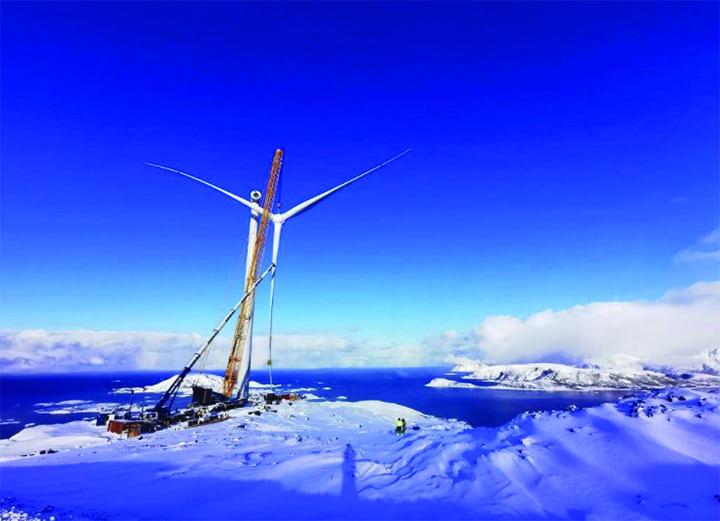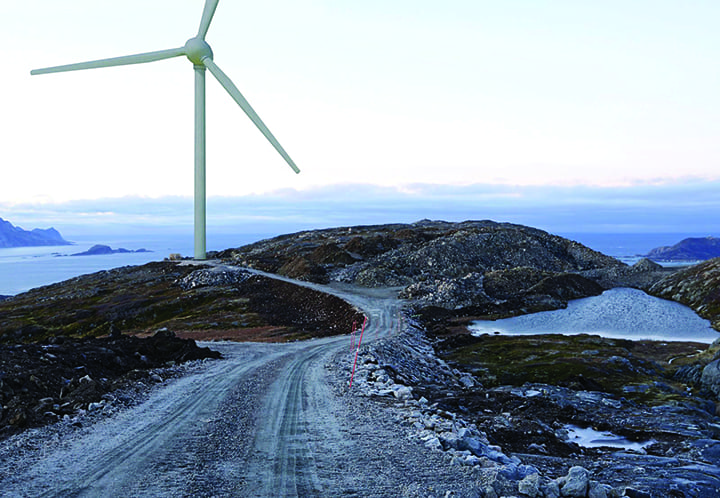Norwegian Wind Farm Presents Construction, Operational Challenges
The global wind power industry continues to grow, as more governments set renewable energy targets amid a push for decarbonization and cleaner energy production. The Wind Europe Intelligence Platform reports China is the world leader with more than 281 GW of installed wind power capacity, followed by the European Union with 192 GW of capacity as of last year. Despite the coronavirus pandemic, 2020 was a record year for global wind power according to the Global Wind Energy Council, with 93 GW of new capacity installed, for a total of 743 GW total wind power capacity worldwide.
Wind energy production continues to grow across the U.S., with several projects set to begin construction this year. Utilities and wind farm operators must constantly assess a variety of operational challenges, both in the construction of new installations, and the operation and maintenance of existing facilities. Among the issues: How are massive wind turbines transported to remote locations? What is necessary for their installation, and what is needed to ensure their continued operation? How should maintenance of equipment, and inspection of the installations, be performed?
A look at the installation and operation of one of Europe’s newest and largest wind farm projects can serve as a case study. FairWind, Siemens Gamesa, and Sarens partnered to design and install the Kvitfjell and Raudfjell wind farm in Norway, and collectively known as “Project Northern Lights.” This study looks at the planning and implementation process behind the installation of 67 wind turbines, each with 4.2 MW of capacity, in a project with an aggregate installed capacity of about 281 MW.
Renewable energy accounted for more than 98% of Norway’s 2020 electricity output, according to a government report, with about 95% of that from hydropower, with wind accounting for much of the rest. The country has moved quickly to reduce its carbon footprint, with key players in the Norwegian oil industry now investing in renewables. The country has been progressively increasing its installed wind power generation capacity in the past decade, with a total of 2,662 MW as of 2020, rising almost six-fold over the past decade. Norway’s efforts are a prime example of a country that is utilizing its natural resources, and made the necessary advancements in renewable energy, to reduce its impact on climate change, as the country takes advantage of its strong winds and hydropower potential from its magnificent fjords.
Site in the Arctic Circle
Construction of the Kvitfjell and Raudfjell farm began in October 2017. It was among Europe’s largest onshore wind projects at the time, and remains among the continent’s largest. The location, about 30 kilometers west of the northern Norwegian city of Tromsø in the Arctic Circle (Figure 1), meant roads needed to be built across the area as a first step in the construction process, before any components could be transported to the site. FairWind and Siemens Gamesa partnered with crane giant Sarens to erect the turbines for the project, tasking Sarens with the transport of all pieces and equipment up the slopes of the snowy mountainous region.
 |
|
1. This map of the project site for the Kvitfjell and Raudfjell wind farm shows the roads that needed to be built to enable the components of the 67 wind turbines to be transported through a mountainous region in the Arctic Circle. Courtesy: Sarens |
Installation of the turbines began in 2019. Equipment needed to be moved from a manufacturing facility to the wind farm site. The turbine parts, including three tower sections, the nacelle, the generator, and the full rotor were loaded into Sarens’ transport vehicles and moved to the location.
 |
|
2. Snowy terrain provides the backdrop as the blades of a wind turbine are lifted for their installation at the wind farm project site in the mountains near Tromsø, Norway. Courtesy: Sarens |
These loads weighed up to 100 tons or more, and had to be transported in snowy conditions, which proved challenging for the project team. A total of four large cranes were necessary to complete the project, including an LG 1750 SX model with booms as long as 105 meters, that Sarens’ team used to lift all wind turbine components and secure into place over a period of several months (Figure 2). The turbines, provided by Siemens Gamesa, were specifically designed to withstand ice and harsh conditions given the location of the farm.
The first team used an LG 1750 SX in SL22 configuration, with a 105-meter boom and 250-tonne counterweight; an AC 220-5 auxiliary crane for tailing the wind turbine components; and an Explorer 5500 as a second auxiliary crane for relocating the main crane. A second team used an LG 1550 in SL configuration with a 98-meter boom and 200-tonne counterweight; an AC 200 auxiliary crane for tailing the components; and an Explorer 5500 to reposition the main crane. The third preassembly team used an AC 500-2 to assemble the first two tower sections, along with an Explorer 5500 auxiliary crane for tailing and relocating the 500-tonne crane.
Cranes Did the Heavy Lifting
Adam Kopaczewski, the onsite project manager for Sarens, said, “In the beginning, there was only one main crane: the LG 1750. After three months, the client decided to order one more main crane team, and from November 2019 onwards we also had the LG 1550 and AC 200 as a second main team.”
Project Northern Lights was completed in October 2020. The wind farm includes 47 Siemens Gamesa SWT-DD-120 wind turbines on the Kvitfjell site and 20 at Raudfjell. Installation of the wind turbines was a critical stage in the process, with each step planned and managed carefully to ensure the timely completion of the farm, as well as its operational success.
 |
|
3. The rugged mountain landscape of northern Norway provided several challenges for construction of the Kvitfjell and Raudfjell wind farm project. The remote area also means operations and maintenance can be problematic, as weather conditions can impact travel to and from the site. Siemens Gamesa Renewable Energy, which led construction management of the project, also manages all current and future maintenance at the site. Courtesy: Sarens |
The wind farm’s location (Figure 3) means its operation has challenges unlike those of many others in less-remote locations, and certainly those operating in less-harsh weather conditions. The project was designed to accommodate the snowy slopes of northern Norway; transporting the turbines, each of which when assembled can weigh as much as 103.5 tons, to the remote site was cited as among the most difficult challenges faced by the project team. The Sarens’ group that moved the equipment and performed the required lifts said adverse weather conditions, and rough terrain, contributed to the difficulty of transport. But the group also said lessons learned from building and operating a wind farm in such a forbidding region can provide lessons for other wind farm operators looking to place installations in remote and harsh areas.
“The biggest challenge faced for all the parties involved in this project was the snow,” said Kopaczewski. “We had up to 7 meters of snow [23 feet] in some areas for more than five months, and wind speeds reaching almost 40 meters/second [90 miles per hour]. Not only that, but being up in the mountains in the Arctic Circle made the project difficult, but we were able to complete the project on time and we’re proud of the impact it will have for the local area.”
In order to complete the transports of the turbine pieces in the set timeframe, Sarens’ team worked in shifts, three days a week over a period of several months to lift and secure each turbine into place. A team of crane drivers, riggers, truck managers, and site managers were involved in the installation process, and careful planning was needed by the project management team to combat the weather conditions at the site.
Remote, Rugged Terrain
To efficiently transport and lift all materials, mobile lattice boom cranes were selected for the project by the site managers due to their relative ease in relocation, as opposed to crawler cranes. The crawler cranes would have needed to be disassembled at each site, and moved across different parts of the mountains for each lift. This decision saved time and allowed the construction team to remain on schedule.
Lattice boom cranes have a boom similar to a crawler crane, but the undercarriage has been adopted from all-terrain cranes. The lattice boom ensures the crane can lift heavy loads; the undercarriage with wheels provides the required mobility, enabling it to move quickly and easily from site to site.
Siemens Gamesa Renewable Energy (SGRE), the company in charge of all aspects of construction management at the site, continues to manage all current and future maintenance, including for the wind turbines, as part of its long-term service contract for the farm. Siemens AS, the company’s energy management division, is positioned to service the main transformers of the wind farm as well as any substation equipment and communication systems.
SGRE said it will cover services and maintenance for an extended turbine lifetime, and reported it has implemented a long-term service program that includes 24/7 condition monitoring to ensure the viability of the wind farm for more than 20 years. The turbines at the site have been specifically designed with cutting-edge de-icing technology to combat the cold climate conditions. ■
—Garima Khanna is group marketing coordinator for Sarens, a Belgian company that specializes in crane rental services, heavy lifting, and engineered transport.